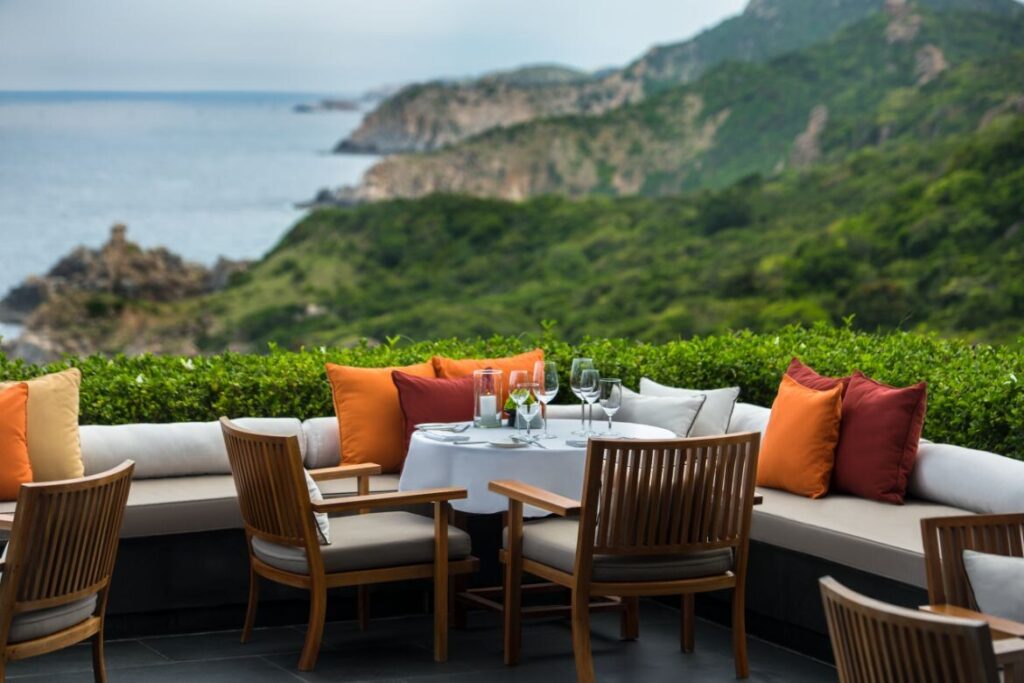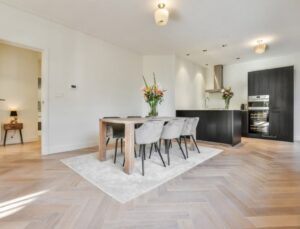3 Asian travel destinations with design and family at the heart
These days, travel does not only include a focus on the destination. Design-focused accommodations have also become important ambassadors for culture while allowing architects and designers to explore the multi-faceted typology.
It also used to be that design hotels and family hotels were divergent in their provisions, with the second focusing on play experiences but sacrificing aesthetics. Here, we highlight three properties in the region beloved by design enthusiasts and parents alike for holistic, inspiring holidays.
1. Amanoi
Designed by Jean-Michel Gathy and his team at Denniston, the creator of many Aman properties, this hotel located in Vietnam’s Ninh Thuan Province is the luxury brand’s first and only property in Vietnam. Opened in 2013, the hotel is located in a remote sanctuary, amid a 29,000-hectare national park (Nui Chua). The design references local vernacular architecture and places importance on sensitivity to site.
“Amanoi showcases an architectural style that draws inspiration from traditional Vietnamese design while incorporating modern luxury elements. Pagoda-style roofs, wooden beams and courtyard elements along with locally sourced materials add a sense of cultural authenticity to the design,” says Joy Arpornrat, general manager of Amanoi. Details to look out for include pathway lamps inspired by fishermen’s baskets, the curving roofs peeping above the tree line to latticed windows and discreet natural materials.”
In 2021, new residences and villas were added, and the pre-existing villas were refurbished. Families can explore and picnic in Nui Chua National Park and the surrounding UNESCO Biosphere Reserve, feast on a Cham menu while gazing at the stars at night or trek the rock formation of Bai Da. Within the hotel, children can enjoy coconut-leaf weaving, sand sculpting, fishing excursions, archery, tennis, cookery classes and painting classes.
Amanoi
aman.com/resorts/amanoi
2. Banyan Tree Phuket
Before Ho Kown Ping and Claire Chiang established Banyan Tree Phuket, it was a disused mine. Their intervention turned the wasteland into a premier hospitality destination, featuring six hotels spread across 1,000 acres of lush parkland. Banyan Tree Phuket is the most premium of them all, featuring only villas.
“Banyan Tree Phuket was designed with a strong emphasis on harmonising with its natural surroundings. The architecture seamlessly blends traditional Thai design elements like the contemporary Lana architecture with modern, minimalist aesthetics,” says Dharmali Kusumadi, senior vice president of Banyan Tree Hotels & Resorts.
There is much focus on retaining Thai culture and sustainability, with the resort “actively engaging with the local community, supporting local artisans and sourcing ingredients for its restaurants from nearby markets,” he adds. Traditional Thai craftsmanship is showcased in Mae Rim tiles from Chiang Mai and Thai teak wood elements.
The pool villas, especially the two- and three-bedroom versions, are perfect for families. A fully equipped kitchen and spacious living area add convenience. “The Double Pool Villas are perfect if you are looking to make the most of your holiday while staying in. It is also equipped with an entertainment room, a wrap-around pool to wade in and our signature pool overlooking the lagoon, a private steam room in the shower and an outdoor area that is perfect for barbecue evenings,” Kusumadi elaborates.
Children can also head to the Ranger’s Club to engage in educational games, as well as arts and crafts such as painting and kite making. A new experience is Open Kitchen, a new farm-to-table café on Laguna Phuket’s grounds. The café focuses on sourcing locally, reducing waste and supporting local farms and artisans. Some of the ingredients come from Banyan Tree’s sustainable agriculture farm Seed Chiang Mai.
After meals, families can walk outside to the public park that encompasses a dog park, maze, and Seed visitor farm to learn about local produce. Alternatively, they can grab a picnic from Open Kitchen to enjoy out in the sun.
Banyan Tree Phuket
banyantree.com
Photography courtesy Banyan Tree
3. Soori Bali
Soori Bali was meant to be a holiday home but Singaporean architect Soo K. Chan decided to expand it into a resort. Located on the edge of the ocean between the Batu Karu Mountain and terraced rice fields, the hotel was first managed under Alila Hotels & Resorts but is now part of Chan’s own Soori hospitality brand. It features contemporary box villas, nestling low into the land.
The architecture and interior design are abstractions of traditional Balinese motifs, such as in the terracotta screens for the spas and restaurants. These are matched with understated terrazzo flooring and walls clad in dark grey volcanic lava stones. With a focus on supporting local communities, about half of the construction workers were recruited from the surrounding community, with many staying on to become hotel staff.
Photography courtesy Soori Bali
Apart from picking stones at the unique black sand beach, children can also enjoy activities such as kite making and fish feeding. Families can take part in Journeys by Soori for an education on local culture. Itineraries include a half-day trip in a vintage convertible Volkswagen, visiting a waterfall at Mount Batukaru, followed by a swim in the shallow natural pool and an organic Soori picnic lunch.
Other unforgettable experiences include joining in on dance classes with young dancers of the centuries-old art of Balinese Legong, and the safe collection of endangered Olive Ridley turtle legs from the resort’s beach. Once hatched and carefully reared, the turtle hatchlings will be released at Kelating Beach in front of Soori Bali.
Soori Bali
sooribali.com
We think you might like to read about these 7 luxury accommodations
The post 3 Asian travel destinations with design and family at the heart appeared first on Habitusliving.com.

These days, travel does not only include a focus on the destination. Design-focused accommodations have also become important ambassadors for culture while allowing architects and designers to explore the multi-faceted typology.
It also used to be that design hotels and family hotels were divergent in their provisions, with the second focusing on play experiences but sacrificing aesthetics. Here, we highlight three properties in the region beloved by design enthusiasts and parents alike for holistic, inspiring holidays.
1. Amanoi
Designed by Jean-Michel Gathy and his team at Denniston, the creator of many Aman properties, this hotel located in Vietnam’s Ninh Thuan Province is the luxury brand’s first and only property in Vietnam. Opened in 2013, the hotel is located in a remote sanctuary, amid a 29,000-hectare national park (Nui Chua). The design references local vernacular architecture and places importance on sensitivity to site.
“Amanoi showcases an architectural style that draws inspiration from traditional Vietnamese design while incorporating modern luxury elements. Pagoda-style roofs, wooden beams and courtyard elements along with locally sourced materials add a sense of cultural authenticity to the design,” says Joy Arpornrat, general manager of Amanoi. Details to look out for include pathway lamps inspired by fishermen’s baskets, the curving roofs peeping above the tree line to latticed windows and discreet natural materials.”
In 2021, new residences and villas were added, and the pre-existing villas were refurbished. Families can explore and picnic in Nui Chua National Park and the surrounding UNESCO Biosphere Reserve, feast on a Cham menu while gazing at the stars at night or trek the rock formation of Bai Da. Within the hotel, children can enjoy coconut-leaf weaving, sand sculpting, fishing excursions, archery, tennis, cookery classes and painting classes.
Amanoi
aman.com/resorts/amanoi
2. Banyan Tree Phuket
Before Ho Kown Ping and Claire Chiang established Banyan Tree Phuket, it was a disused mine. Their intervention turned the wasteland into a premier hospitality destination, featuring six hotels spread across 1,000 acres of lush parkland. Banyan Tree Phuket is the most premium of them all, featuring only villas.
“Banyan Tree Phuket was designed with a strong emphasis on harmonising with its natural surroundings. The architecture seamlessly blends traditional Thai design elements like the contemporary Lana architecture with modern, minimalist aesthetics,” says Dharmali Kusumadi, senior vice president of Banyan Tree Hotels & Resorts.
There is much focus on retaining Thai culture and sustainability, with the resort “actively engaging with the local community, supporting local artisans and sourcing ingredients for its restaurants from nearby markets,” he adds. Traditional Thai craftsmanship is showcased in Mae Rim tiles from Chiang Mai and Thai teak wood elements.
The pool villas, especially the two- and three-bedroom versions, are perfect for families. A fully equipped kitchen and spacious living area add convenience. “The Double Pool Villas are perfect if you are looking to make the most of your holiday while staying in. It is also equipped with an entertainment room, a wrap-around pool to wade in and our signature pool overlooking the lagoon, a private steam room in the shower and an outdoor area that is perfect for barbecue evenings,” Kusumadi elaborates.
Children can also head to the Ranger’s Club to engage in educational games, as well as arts and crafts such as painting and kite making. A new experience is Open Kitchen, a new farm-to-table café on Laguna Phuket’s grounds. The café focuses on sourcing locally, reducing waste and supporting local farms and artisans. Some of the ingredients come from Banyan Tree’s sustainable agriculture farm Seed Chiang Mai.
After meals, families can walk outside to the public park that encompasses a dog park, maze, and Seed visitor farm to learn about local produce. Alternatively, they can grab a picnic from Open Kitchen to enjoy out in the sun.
Banyan Tree Phuket
banyantree.com
Photography courtesy Banyan Tree
3. Soori Bali
Soori Bali was meant to be a holiday home but Singaporean architect Soo K. Chan decided to expand it into a resort. Located on the edge of the ocean between the Batu Karu Mountain and terraced rice fields, the hotel was first managed under Alila Hotels & Resorts but is now part of Chan’s own Soori hospitality brand. It features contemporary box villas, nestling low into the land.
The architecture and interior design are abstractions of traditional Balinese motifs, such as in the terracotta screens for the spas and restaurants. These are matched with understated terrazzo flooring and walls clad in dark grey volcanic lava stones. With a focus on supporting local communities, about half of the construction workers were recruited from the surrounding community, with many staying on to become hotel staff.
Photography courtesy Soori Bali
Apart from picking stones at the unique black sand beach, children can also enjoy activities such as kite making and fish feeding. Families can take part in Journeys by Soori for an education on local culture. Itineraries include a half-day trip in a vintage convertible Volkswagen, visiting a waterfall at Mount Batukaru, followed by a swim in the shallow natural pool and an organic Soori picnic lunch.
Other unforgettable experiences include joining in on dance classes with young dancers of the centuries-old art of Balinese Legong, and the safe collection of endangered Olive Ridley turtle legs from the resort’s beach. Once hatched and carefully reared, the turtle hatchlings will be released at Kelating Beach in front of Soori Bali.
Soori Bali
sooribali.com
We think you might like to read about these 7 luxury accommodations
The post 3 Asian travel destinations with design and family at the heart appeared first on Habitusliving.com.





